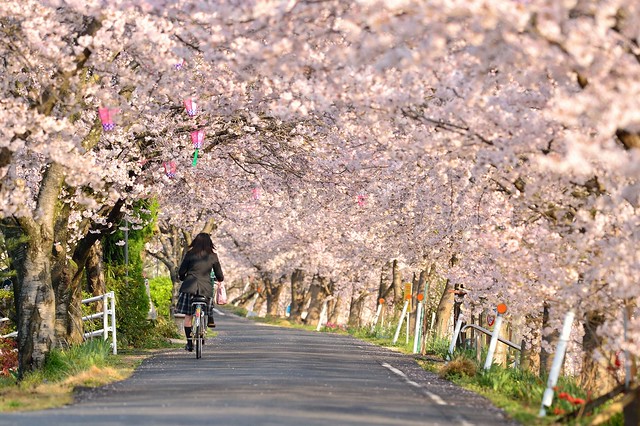Cherry blossom season has once again returned to Japan. While the arrival of the delicate pink flowers means social media is filling up with some incredibly beautiful photos, the bloom also is a chance to reflect, hope, dream, and come to terms with loss.
In Iwaki, Fukushima Prefecture, the Iwaki Manbon Sakura (which roughly translates as “10,000 Cherry Tress of Iwaki”) Project represents just this.
Iwaki lies just 50 km south of the stricken Fukushima Daiichi nuclear power complex. The city was affected by the massive tsunami that struck Japan's Pacific coast following a massive earthquake in March 2011. Iwaki was also affected by the nuclear disaster at the Fukushima power plant.
As part of the Iwaki Manbon Sakura Project, to mark the fourth anniversary of the massive disaster, the group hopes to plant 99,000 cherry trees on a hill overlooking the city (the “10,000” number in the group's name is a poetic, term that can sometimes mean “many” or “infinite).
Tadashige Shiga, whose company helps sponsor the project explains:
負の遺産を残してしまうことにすごい悲しさ、悔しさを今さらながら感じています。なんとかならないものなのでしょうか!春、桜の花が満開に咲いているのを見て、20年後、30年後の未来の子供達に、山一面の桜を見てもらえるようにしようと思いたちました。万が一いわきに住めなくなった時でさえ、いわきの土地を愛していた人達の気持ちが伝わるくらい、沢山の桜の木を植えたいと思っています。
The effects of the March 2011 disaster have left a pall of sadness here. So let's do something to fix that! Every year the cherry trees blossom. So let's give kids 20 years from now, 30 years from now something to look upon when they gaze up at the mountain slopes above Iwaki. Even if for some reason no one can live in Iwaki, we can still express the love we all feel for our city for all time, and we can do that by planting cherry trees.
The idea is that cherry trees and their spring blossoms will be able to soothe some of the memories of terror and sadness caused by the 2011 tragedy.
Sakura‘s long history
Japan's connections with cherry blossoms, or sakura, run deep. The short-lived blooms appear in the Man'yōshū, the oldest existing collection of Japanese poetry, written nearly 1,300 years ago during Japan's Nara period.
Throughout Japan's history cherry blossoms have represented new beginnings, hopes and dreams. The blossoms are beautiful enough to take one's breath away and then quickly disappear. Cherry blossoms stir a mixture of emotions and occupy a special place in the hearts of Japanese people.
Today the arrival of cherry blossoms each year in late March marks more than a change of season. Cherry blossoms also coincide with graduation and the end of the school year at the end of March, and the start of a new school year at the beginning of April.
This season, Japanese Twitter users have posted some stunning pictures of sakura in bloom:
今年の春に・・・ #ファインダー越しの私の世界 #写真撮ってる人と繋がりたい #写真好きな人と繋がりたい pic.twitter.com/9QKvXHqrok
— shara_photo@△ (@shara_photo) November 24, 2014
Spring has arrived.
スカイツリーの河津桜がそろそろ満開 pic.twitter.com/9urWao0Zvh
— すえきち (@suekichiii) March 10, 2015
The cherry trees beneath Tokyo Skytree are nearly in full bloom.
Twitter user @7D_ITACHI managed to capture a timeless image of Japan:
4年ぶりに故郷へ戻る事ができました。この場所はやっぱり落ち着くな〜 #夜桜 #高田城 #写真好きな人と繋がりたい pic.twitter.com/xNg8XVg9KL
— イタチ (@7D_ITACHI) April 16, 2014
Back home in Joetsu for the first time in four years. It's really peaceful here.
As the sakura bloom it's the season of new journeys:
春ってなんかわくわくして 桜とかが綺麗に咲いたりして 前までわ好きだったけど いろんな人達との別れが多いな~ 今わ春が嫌いだ
— みらい✡ (@3jsb24Giants) March 28, 2015
It's always wonderful in spring as the beautiful sakura are in bloom. While I have always loved springtime at the moment I'm hating it as I have to leave old friends behind.
As the cherry petals begin to fall in drifts, they begin to express a powerful sense of separation:
【桜の絨毯と吹雪】 →http://t.co/kO1MwAiPfq 境内を歩くとあちらこちらで桜吹雪が舞っています。(長野県中野市 谷厳寺の桜) #風景 #桜 pic.twitter.com/1tOgZE4ZKF
— pixpot photo (@pixpotjp) March 5, 2015
“A blizzard of cherry blossoms” > Cherry blossom lie in drifts in temple grounds. (Kokugon Temple, Nagano)
Cherry blossoms seem to have a profound effect on the human soul.
今年はじめて桜をみつけた!疲れてたけどもうちょっとがんばろうと思った pic.twitter.com/cot3GeJdir
— 大石蘭 (@wireless_RAN) March 26, 2015
I have spotted the first cherry trees of the season! Although I'm pretty tired, I think I can keep on going on for a little while longer.







2 comments
“In Iwaki, Fukushima Prefesture, …”
“Prefecture”, not “prefesture”. Does anybody proofread articles here?
Thanks for pointing that out! It’s fixed. These things slip by sometimes. We are human, after all.